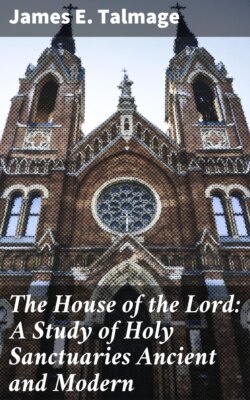Читать книгу The House of the Lord: A Study of Holy Sanctuaries Ancient and Modern - James E. Talmage - Страница 12
На сайте Литреса книга снята с продажи.
THE TEMPLE OF EZEKIEL'S VISION
ОглавлениеTable of Contents
In the twenty-fifth year of the Babylonian captivity, while yet the people of Israel were in exile in a strange land, the word of the Lord came to the prophet Ezekiel; the power of God rested upon him; and he saw in vision a glorious Temple, the plan of which he minutely described.[63] As to whether the prophet himself considered the design so shown as one to be subsequently realized, or as but a grand yet unattainable ideal, is not declared. Certain it is that the Temple of the vision has not yet been builded.
In most of its essential features Ezekiel's ideal followed closely the plan of Solomon's Temple; so close, indeed, is the resemblance, that many of the details specified by Ezekiel have been accepted as those of the splendid edifice destroyed by Nebuchadnezzar. A predominant characteristic of the Temple described by Ezekiel was the spaciousness of its premises and the symmetry of both the Holy House and its associated buildings. The area was to be a square of five hundred cubits, walled about and provided with a gateway and arches on each of three sides; on the west side the wall was to be unbroken by arch or portal. At each of the gateways were little chambers regarded as lodges,[64] and provided with porches. In the outer court were other chambers. The entire area was to be elevated, and a flight of steps led to each gateway. In the inner court was seen the great altar, standing before the House, and occupying the center of a square of one hundred cubits.[65] Ample provision was made for every variety of sacrifice and offering, and for the accommodation of the priests, the singers, and all engaged in the holy ritual.[66] The main structure comprised a Porch, a Holy Place, and an inner sanctuary or Most Holy Place, the last named elevated above the rest and reached by steps. The plan provided for even greater exclusiveness than had characterized the sacred area of the Temple of Solomon; the double courts contributed to this end. The service of the Temple was prescribed in detail; the ordinances of the altar, the duties of the priests, the ministry of the Levites, the regulations governing oblations and feasts were all set forth.[67]
The immediate purpose of this revelation through the vision of the prophet appears to have been that of awakening the people of Israel to a realization of their fallen state and a conception of their departed glory. The prophet was thus commanded:
"Thou son of man, shew the house to the house of Israel, that they may be ashamed of their iniquities: and let them measure the pattern.
"And if they be ashamed of all that they have done, show them the form of the house, and the fashion thereof, and the goings out thereof, and the comings in thereof, and all the forms thereof, and all the ordinances thereof, and all the forms thereof, and all the laws thereof: and write it in their sight, that they may keep the whole form thereof, and all the ordinances thereof, and do them.
"This is the law of the house; Upon the top of the mountain the whole limit thereof round about shall be most holy. Behold, this is the law of the house."[68]
